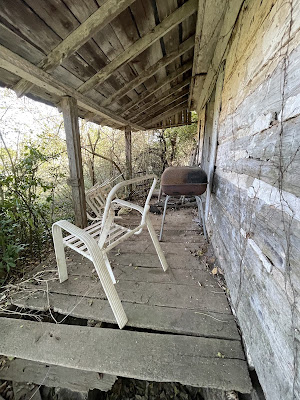 |
| Farmer Campbell Ridley stands near a slave cabin where sharecropper Katy Yokley, great-grandmother of NFL standout Dont'a Hightower, lived. |
Within site of Pillow's mansion called Clifton Place, we explored inside one of the cabins — gingerly stepping on the creaky wooden floor, picking through artifacts, and wondering about the lives of the enslaved. The visit to "The Quarters," slave row, was fascinating ... and humbling.
 |
| A brick fireplace in one of the cabins. |
 |
| Ancient logs of the slave cabin where sharecropper Katy Yokley lived. She was NFL star Dont'a Hightower's great-grandmother. |
 |
| The porch of the slave cabin where NFL standout Dont'a Hightower's great-grandmother lived. The home is abandoned. |
Now this is a connection worth exploring further.
If he were alive today, Gideon Johnson Pillow would post a daily selfie to Facebook, craft look-at-me entries on his blog about his Corvette collection, flood Instagram with images of his circa-1840, 12-room, Greek Revival-style mansion, and tweet thousands of times about his hemp crop, which made him one of Tennessee's wealthiest men.
On Clifton Place tours on YouTube — the planter would be an influencer, of course — Pillow surely would brag about the full-length painting in the foyer of ... Gideon Pillow in a military uniform. (Hmmm, whom does this remind us of...? 😄)
The scouting report on Pillow from my historian friends Tom Price and Rachael Finch was not kind.
"Huge chip on his shoulder."
"Vain."
 |
| A painting of Gideon Pillow at the Tennessee State Museum in Nashville. |
"Anything he posted to Instagram would be perfectly curated," which is probably the first time those nine words were typed referencing any Civil War general.
Pillow's contemporaries also were scornful. In mid-February 1862, Ulysses Grant threw massive shade Pillow's way while discussing terms of surrender of the Confederate garrison at Fort Donelson with Rebel General Simon Bolivar Buckner, his old friend. The previous night, Pillow — whom Grant knew from the Mexican War — escaped across the Cumberland River in a small boat.
Buckner: “He thought you’d rather get ahold of him than any other man in the Southern Confederacy.”
Grant: "Oh, if I had got him, I’d let him go. He will do more good commanding you fellows.”
In his 1864 memoirs, Winfield "Old Fuss and Feathers" Scott — commanding general of the U.S. Army when the Civil War broke out — described Pillow as "amiable, and possessed of some acuteness, but the only person I have ever known who was wholly indifferent in the choice between truth and falsehood, honesty and dishonesty; ever as ready to attain an end by the one as the other, and habitually boastful of acts of cleverness at the total sacrifice of moral character."
Not a ringing endorsement.
At Fort Donelson (Feb. 13-16, 1862) and Stones River (Dec. 31, 1862-Jan. 2, 1863), Pillow’s generalship was underwhelming at best. After Stones River, he spent much of the rest of the war recruiting.
 |
| Clifton Place, the circa-1840 mansion built for Gideon Pillow. I took this mansion image during an escorted visit in February 2021. |
 |
| The brick stable (foreground) at Gideon Pillow's plantation. The 12-room Clifton Place mansion appears in the left background. PRIVATE PROPERTY: Do not trespass. |
Like most wealthy men in the South, Pillow owned slaves. Seventy toiled at his plantation, about a day's ride from Columbia back in the day. Ten or so served their master's domestic needs (cooking, cleaning, caring for children), and were housed in crude cabins near Clifton Place. The rest, who lived on slave row, worked the fields. Enslaved labor made Pillow a millionaire.
 |
| The exterior of one of the four surviving slave cabins. |
"He wanted everyone to know he had money," she said.
For Pillow, the effort to impress was partly to keep up with the Joneses... or Polks, in his case. Just down Mount Pleasant Pike were the impressive plantations of the Polk brothers — Ashwood Hall, perhaps the most fabulous plantation mansion in Tennessee, was originally built for Leonidas Polk, who also became a Confederate general. ("The Fighting Bishop" lived until June 14, 1864, when he was nearly sliced in two by Yankee artillery at Pine Mountain, Ga.)
Pillow, who went bankrupt after the war, died in 1878. If he were able to post, blog or tweet today, he could brag about something else — the state of his plantation complex.
"One of the most intact ... in Middle Tennessee," Finch said of the private property.
-- Have something to add (or correct) in this post? Email me here.
SOURCE
- Hamilton, James. The Battle of Fort Donelson. T. Yoseloff, South Brunswick, N.J., 1968.

Worked their for years. Father was project director for JRN Inc.
ReplyDeleteClifton Place is in Giles County, approx 7 miles NW of Pulaski. Google it.
ReplyDelete